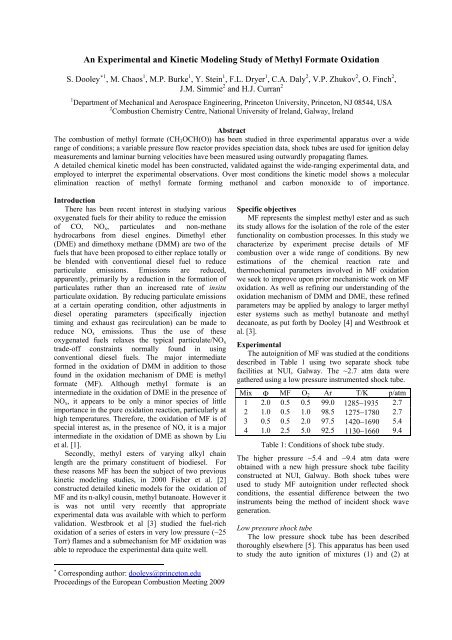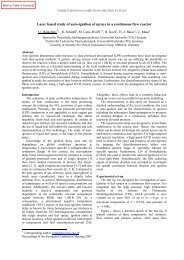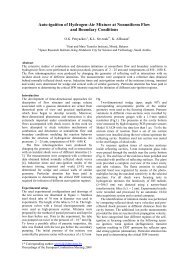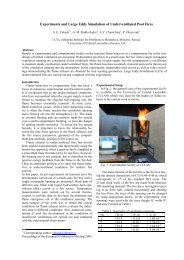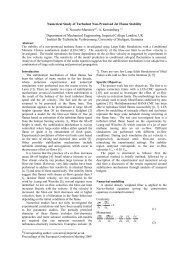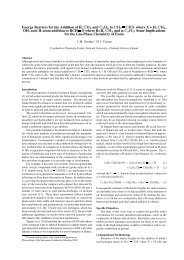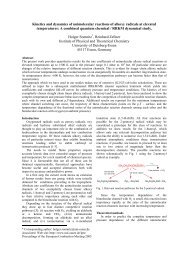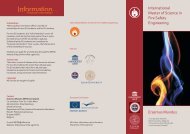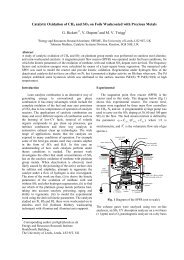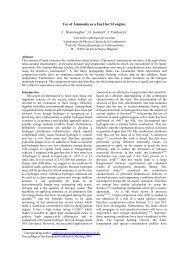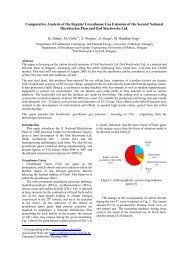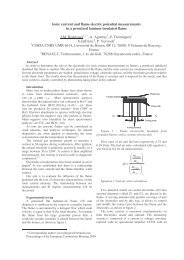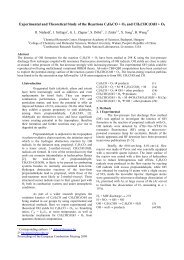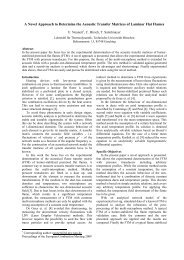An experimental and kinetic modeling study of methyl formate ...
An experimental and kinetic modeling study of methyl formate ...
An experimental and kinetic modeling study of methyl formate ...
You also want an ePaper? Increase the reach of your titles
YUMPU automatically turns print PDFs into web optimized ePapers that Google loves.
<strong>An</strong> Experimental <strong>and</strong> Kinetic Modeling Study <strong>of</strong> Methyl Formate Oxidation<br />
S. Dooley ∗1 , M. Chaos 1 , M.P. Burke 1 , Y. Stein 1 , F.L. Dryer 1 , C.A. Daly 2 , V.P. Zhukov 2 , O. Finch 2 ,<br />
J.M. Simmie 2 <strong>and</strong> H.J. Curran 2<br />
1 Department <strong>of</strong> Mechanical <strong>and</strong> Aerospace Engineering, Princeton University, Princeton, NJ 08544, USA<br />
2 Combustion Chemistry Centre, National University <strong>of</strong> Irel<strong>and</strong>, Galway, Irel<strong>and</strong><br />
Abstract<br />
The combustion <strong>of</strong> <strong>methyl</strong> <strong>formate</strong> (CH3OCH(O)) has been studied in three <strong>experimental</strong> apparatus over a wide<br />
range <strong>of</strong> conditions; a variable pressure flow reactor provides speciation data, shock tubes are used for ignition delay<br />
measurements <strong>and</strong> laminar burning velocities have been measured using outwardly propagating flames.<br />
A detailed chemical <strong>kinetic</strong> model has been constructed, validated against the wide-ranging <strong>experimental</strong> data, <strong>and</strong><br />
employed to interpret the <strong>experimental</strong> observations. Over most conditions the <strong>kinetic</strong> model shows a molecular<br />
elimination reaction <strong>of</strong> <strong>methyl</strong> <strong>formate</strong> forming methanol <strong>and</strong> carbon monoxide to <strong>of</strong> importance.<br />
Introduction<br />
There has been recent interest in <strong>study</strong>ing various<br />
oxygenated fuels for their ability to reduce the emission<br />
<strong>of</strong> CO, NOx, particulates <strong>and</strong> non-methane<br />
hydrocarbons from diesel engines. Di<strong>methyl</strong> ether<br />
(DME) <strong>and</strong> dimethoxy methane (DMM) are two <strong>of</strong> the<br />
fuels that have been proposed to either replace totally or<br />
be blended with conventional diesel fuel to reduce<br />
particulate emissions. Emissions are reduced,<br />
apparently, primarily by a reduction in the formation <strong>of</strong><br />
particulates rather than an increased rate <strong>of</strong> insitu<br />
particulate oxidation. By reducing particulate emissions<br />
at a certain operating condition, other adjustments in<br />
diesel operating parameters (specifically injection<br />
timing <strong>and</strong> exhaust gas recirculation) can be made to<br />
reduce NOx emissions. Thus the use <strong>of</strong> these<br />
oxygenated fuels relaxes the typical particulate/NOx<br />
trade-<strong>of</strong>f constraints normally found in using<br />
conventional diesel fuels. The major intermediate<br />
formed in the oxidation <strong>of</strong> DMM in addition to those<br />
found in the oxidation mechanism <strong>of</strong> DME is <strong>methyl</strong><br />
<strong>formate</strong> (MF). Although <strong>methyl</strong> <strong>formate</strong> is an<br />
intermediate in the oxidation <strong>of</strong> DME in the presence <strong>of</strong><br />
NOx, it appears to be only a minor species <strong>of</strong> little<br />
importance in the pure oxidation reaction, particularly at<br />
high temperatures. Therefore, the oxidation <strong>of</strong> MF is <strong>of</strong><br />
special interest as, in the presence <strong>of</strong> NO, it is a major<br />
intermediate in the oxidation <strong>of</strong> DME as shown by Liu<br />
et al. [1].<br />
Secondly, <strong>methyl</strong> esters <strong>of</strong> varying alkyl chain<br />
length are the primary constituent <strong>of</strong> biodiesel. For<br />
these reasons MF has been the subject <strong>of</strong> two previous<br />
<strong>kinetic</strong> <strong>modeling</strong> studies, in 2000 Fisher et al. [2]<br />
constructed detailed <strong>kinetic</strong> models for the oxidation <strong>of</strong><br />
MF <strong>and</strong> its n-alkyl cousin, <strong>methyl</strong> butanoate. However it<br />
is was not until very recently that appropriate<br />
<strong>experimental</strong> data was available with which to perform<br />
validation. Westbrook et al [3] studied the fuel-rich<br />
oxidation <strong>of</strong> a series <strong>of</strong> esters in very low pressure (~25<br />
Torr) flames <strong>and</strong> a submechanism for MF oxidation was<br />
able to reproduce the <strong>experimental</strong> data quite well.<br />
∗ Corresponding author: dooleys@princeton.edu<br />
Proceedings <strong>of</strong> the European Combustion Meeting 2009<br />
Specific objectives<br />
MF represents the simplest <strong>methyl</strong> ester <strong>and</strong> as such<br />
its <strong>study</strong> allows for the isolation <strong>of</strong> the role <strong>of</strong> the ester<br />
functionality on combustion processes. In this <strong>study</strong> we<br />
characterize by experiment precise details <strong>of</strong> MF<br />
combustion over a wide range <strong>of</strong> conditions. By new<br />
estimations <strong>of</strong> the chemical reaction rate <strong>and</strong><br />
thermochemical parameters involved in MF oxidation<br />
we seek to improve upon prior mechanistic work on MF<br />
oxidation. As well as refining our underst<strong>and</strong>ing <strong>of</strong> the<br />
oxidation mechanism <strong>of</strong> DMM <strong>and</strong> DME, these refined<br />
parameters may be applied by analogy to larger <strong>methyl</strong><br />
ester systems such as <strong>methyl</strong> butanoate <strong>and</strong> <strong>methyl</strong><br />
decanoate, as put forth by Dooley [4] <strong>and</strong> Westbrook et<br />
al. [3].<br />
Experimental<br />
The autoignition <strong>of</strong> MF was studied at the conditions<br />
described in Table 1 using two separate shock tube<br />
facilities at NUI, Galway. The ~2.7 atm data were<br />
gathered using a low pressure instrumented shock tube.<br />
Mix Φ MF O2 Ar T/K p/atm<br />
1 2.0 0.5 0.5 99.0 1285−1935 2.7<br />
2 1.0 0.5 1.0 98.5 1275−1780 2.7<br />
3 0.5 0.5 2.0 97.5 1420−1690 5.4<br />
4 1.0 2.5 5.0 92.5 1130−1660 9.4<br />
Table 1: Conditions <strong>of</strong> shock tube <strong>study</strong>.<br />
The higher pressure ~5.4 <strong>and</strong> ~9.4 atm data were<br />
obtained with a new high pressure shock tube facility<br />
constructed at NUI, Galway. Both shock tubes were<br />
used to <strong>study</strong> MF autoignition under reflected shock<br />
conditions, the essential difference between the two<br />
instruments being the method <strong>of</strong> incident shock wave<br />
generation.<br />
Low pressure shock tube<br />
The low pressure shock tube has been described<br />
thoroughly elsewhere [5]. This apparatus has been used<br />
to <strong>study</strong> the auto ignition <strong>of</strong> mixtures (1) <strong>and</strong> (2) at
eflected shock pressures <strong>of</strong> 2.7 ± 0.3 atm <strong>and</strong> reflected<br />
shock temperatures <strong>of</strong> 1275−1935 K, Table 1.<br />
High pressure shock tube<br />
The high pressure shock tube facility existed in a<br />
previous carnation in the laboratory <strong>of</strong> Pr<strong>of</strong>. Cadman [6]<br />
<strong>and</strong> maintains essentially the same parameters <strong>of</strong><br />
operation <strong>and</strong> performance. Re-commissioned in 2007<br />
this shock tube consists <strong>of</strong> an 876 cm stainless steel tube<br />
<strong>of</strong> internal diameter 63 mm, divided into a 300 cm long<br />
driver section <strong>and</strong> a test section 573 cm in length. The<br />
high pressure drive section is further divided for the<br />
generation <strong>of</strong> shock waves by the double diaphragm<br />
rupturing technique. Polycarbonate diaphragms separate<br />
a small chamber containing helium drive gas at<br />
intermediate pressure from the high pressure drive<br />
section <strong>and</strong> the low pressure test section. The sudden<br />
evacuation <strong>of</strong> this intermediate pressure causes both<br />
diaphragms to rupture allowing incident shock waves to<br />
form in a reproducible manner. This apparatus was used<br />
to generate higher pressure reflected shock waves <strong>of</strong> 5.4<br />
± 0.4 atm <strong>and</strong> 9.4 ± 0.4 atm for the <strong>study</strong> <strong>of</strong> mixtures<br />
(3) <strong>and</strong> (4) respectively, Table 1.<br />
Similarly to the low pressure shock tube<br />
arrangement, three pressure transducers (PCB 113A24)<br />
were set into the final 50 cm <strong>of</strong> the test section <strong>and</strong> a<br />
fourth is embedded in the end wall. In conjunction with<br />
three time counters (Fluke PM6666) these pressure<br />
sensors allow for the measurement <strong>of</strong> the incident shock<br />
velocity at three points as the shock wave passes along<br />
the test section. Reflected shock conditions were<br />
calculated using one-dimensional shock relations as<br />
implemented by the application GasEq [7]. The<br />
estimated error in the measurement <strong>of</strong> incident shock<br />
velocity corresponds to an uncertainty in reflected shock<br />
temperature <strong>of</strong> ± 7 K, such is represented by error bars<br />
in Figs. 3 & 4 [8].<br />
In both apparatus helium CP Grade 99.999%, was<br />
used as drive gas. Test gas mixtures for <strong>study</strong> in both<br />
instruments were prepared in 50 L stainless steel tanks<br />
using st<strong>and</strong>ard manometric methods, argon was Zero<br />
Grade 99.998%, <strong>and</strong> oxygen was Research Grade<br />
99.985%. All gases were obtained from BOC Irel<strong>and</strong><br />
Ltd <strong>and</strong> used without further purification. Methyl<br />
<strong>formate</strong> as 99.5% pure was obtained from Aldrich<br />
Chemical Co. Ltd. To minimize the presence <strong>of</strong><br />
atmospheric air in the liquid fuel the sample was<br />
subjected to several freeze-pump-thaw degassing cycles<br />
before being incorporated into the test mixture by<br />
vaporization into the evacuated mixing tanks. The high<br />
pressure shock tube facility uses a Wallace <strong>and</strong> Tiernan<br />
(61b-1a-0050e) 0−3400 mbar pressure gauge to measure<br />
fuel, oxygen <strong>and</strong> diluent partial pressures. Test gas<br />
mixtures were normally made up to a final pressure <strong>of</strong><br />
800 Torr <strong>and</strong> allowed to st<strong>and</strong> for at least 12 hours to<br />
ensure homogeneity.<br />
Light emission was observed in each experiment<br />
with the use <strong>of</strong> a 431.5 nm narrow b<strong>and</strong>pass filter with a<br />
spectral b<strong>and</strong>width <strong>of</strong> 10 nm. The filters <strong>and</strong> the light<br />
diagnostics were aligned behind quartz windows located<br />
2<br />
in each end wall. The pressure transducers, mounted<br />
flush with each end wall, signaled the shock wave<br />
arrival at the end wall <strong>and</strong> the beginning <strong>of</strong> the ignition<br />
delay period. The end <strong>of</strong> the period was defined as the<br />
maximum rate <strong>of</strong> CH* emission.<br />
Variable Pressure Flow Reactor (VPFR)<br />
The design <strong>and</strong> operating characteristics <strong>of</strong> the<br />
Princeton VPFR have been discussed in detail<br />
elsewhere [9−11]. In the present experiments, nitrogen<br />
carrier gas was heated by an electric resistance heater<br />
<strong>and</strong> mixed with oxygen as it entered a 10.2-cm-diameter<br />
quartz test section. MF (99.5%, Aldrich Chemical Co.<br />
Ltd.) was supplied from a liquid evaporator system,<br />
diluted with additional nitrogen. The diluted fuel vapor<br />
was rapidly mixed with the carrier gas at the entrance to<br />
a conical shaped silica foam diffuser. The reaction<br />
temperature <strong>of</strong> flow at the sampling location, with all<br />
flows established except the fuel flow, varied by less<br />
than ~2 K. During operation <strong>of</strong> the VPFR, all flow rates<br />
<strong>of</strong> carrier, diluent, <strong>and</strong> reactants were metered <strong>and</strong> held<br />
constant for the entire duration <strong>of</strong> each set <strong>of</strong><br />
experiments reported. The initial reaction temperature<br />
not accounting for combustive heat release was held<br />
constant. Throughout the course <strong>of</strong> each experiment the<br />
reaction pressure was modified so as to maintain the<br />
initial reaction pressure. The reaction temperature at the<br />
sampling location <strong>and</strong> all sample analytical readings<br />
were allowed to achieve steady state, before the data<br />
were digitally recorded.<br />
The reaction (residence) time was varied by<br />
changing the distance between the fuel injection<br />
location <strong>and</strong> the fixed sampling probe. The sampled gas<br />
flow was transferred through heated Teflon lines to a<br />
series <strong>of</strong> analytical equipment including a Fourier<br />
transform infrared (FTIR) spectrometer (Nicolet Model<br />
560), an electrochemical oxygen (O2) analyzer (Infrared<br />
Industries Model 2200), <strong>and</strong> non-dispersive carbon<br />
monoxide (CO) <strong>and</strong> carbon dioxide (CO2) analyzers<br />
(Horiba Model PIR 2000). The uncertainties in the<br />
measurements reported here are: O2 < 4%; CO < 3%;<br />
CO2 < 3% <strong>of</strong> the reading. The other major species<br />
identified during the oxidation <strong>of</strong> MF were H2O (water),<br />
CH3OH (methanol), CH2O (formaldehyde) <strong>and</strong> CH4<br />
(methane). These species were quantified by online<br />
FTIR spectroscopy, estimated uncertainties in these<br />
measurements are: H2O < 5%; MF < 3%; CH3OH < 3%;<br />
CH2O ~10%; CH4 < 3% <strong>of</strong> the reported value.<br />
Set Φ MF O2 N2 T/K p/atm<br />
1 0.5 0.5 2.0 97.5 900 3.0<br />
2 1.0 0.5 1.0 98.5 903 3.0<br />
3 1.5 0.5 0.67 98.8 900 3.0<br />
Table 2: Conditions <strong>of</strong> VPFR <strong>study</strong><br />
The oxidation <strong>of</strong> MF was studied using 0.5% fuel, at<br />
three equivalence ratios (Φ): 0.5, 1.0 <strong>and</strong> 1.5. Pressure<br />
was held constant at 3 atm <strong>and</strong> initial reactor<br />
temperatures were ~900 K, Table 2. The reaction was<br />
followed as a function <strong>of</strong> time until the fuel <strong>and</strong> major<br />
intermediates had been consumed, ~0.7 seconds.
Dual chambered cylindrical bomb<br />
The burning velocities <strong>of</strong> MF/O2/N2 flames were<br />
measured as a function Φ using outwardly propagating<br />
flames in a dual-chambered, pressure-release type highpressure<br />
combustion apparatus as described in detail<br />
elsewhere [12]. In the present <strong>study</strong>, the device was<br />
operated in the “closed” configuration, <strong>and</strong> may be<br />
treated as a constant-volume cylindrical bomb. Mixtures<br />
were prepared in the constant volume chamber by the<br />
partial pressure method using an absolute pressure<br />
gauge (Cecomp Electronics Inc.) <strong>of</strong> 0.25% full scale<br />
accuracy. For all experiments <strong>methyl</strong> <strong>formate</strong><br />
(anhydrous, 99%, Aldrich Chemical Co. Ltd.) was<br />
diluted to a pressure <strong>of</strong> 1 atm with synthetic air, i.e. O-<br />
2:N2 = 1:3.78, consisting <strong>of</strong> Zero Grade nitrogen<br />
(99.998%) <strong>and</strong> Research Grade oxygen (99.5%)<br />
supplied by Airgas Ltd. Due care was taken to ensure<br />
that there was minimal contamination <strong>of</strong> the <strong>methyl</strong><br />
<strong>formate</strong> vapor in filling the combustion chamber. The<br />
mixtures were allowed to homogenise for 30 minutes<br />
prior to spark induced ignition by a high voltage<br />
tungsten filament. The initial temperature <strong>of</strong> each<br />
experiment was 295±2K.<br />
The flame radius was recorded from Schlieren<br />
images obtain with a high speed video camera as a<br />
function <strong>of</strong> time. The instantaneous flame speed (su) is<br />
calculated using a flow correction term (ϖ) [13]. The<br />
flow correction term is employed to account for the<br />
actual gas motions induced by combustion, rather than<br />
the conventional zero burned gas velocity assumption<br />
(ϖ = 0). The expansion factor (σ) is defined as the ratio<br />
<strong>of</strong> the unburned to burned gas densities across the flame<br />
front.<br />
1 drf<br />
s = σ dt<br />
u<br />
⎛ σ −1<br />
⎞<br />
⎜1+<br />
ϖ ⎟<br />
⎝ σ ⎠<br />
The definition <strong>of</strong> stretch rate (κ) is that <strong>of</strong> Strehlow<br />
<strong>and</strong> Savage [14] <strong>and</strong> may be related to the flame radius<br />
(rf) <strong>and</strong> flame front velocity (drf /dt) by,<br />
2 drf<br />
κ =<br />
rf<br />
dt<br />
The laminar burning velocity (su o ), is obtained<br />
through linear extrapolation <strong>of</strong> the flame speed to a<br />
value <strong>of</strong> zero stretch rate using a linear stretch relation,<br />
o<br />
su<br />
= su<br />
− Lu<br />
⋅κ<br />
where Lu is the Markstein length. Prolonged unsteady<br />
ignition effects were observed up to flame radii <strong>of</strong> 1 cm<br />
for some conditions. Therefore, linear extrapolation to<br />
the laminar burning velocity is performed for flame<br />
radii ranging from 1 to 2 cm where the quasi steady<br />
linear stretch relationship appears more valid. This<br />
methodology was tested by extrapolating to zero stretch<br />
rate over four distinct ranges <strong>of</strong> flame radii (from 1 to<br />
3cm) for each experiment. This treatment produced<br />
burning velocities which were typically consistent<br />
3<br />
within 3% (the value <strong>of</strong> the error bars presented in Fig.<br />
5). Four experiments were conducted at the<br />
stoichiometric condition, where mixing time was varied<br />
from 30 to 115 minutes. The burning velocity for each<br />
case is consistent within 2%. All other values presented<br />
are obtained from single experiments.<br />
Computational Simulations<br />
The <strong>modeling</strong> computations in this <strong>study</strong> were<br />
carried out using the Chemkin suite <strong>of</strong> programs<br />
(SENKIN <strong>and</strong> PREMIX) [15]. Shock tube simulations<br />
assume constant volume adiabatic conditions behind the<br />
reflected shock wave <strong>and</strong> we define the simulated<br />
ignition delay time as in [8].<br />
The VPFR experiments may be modeled as a zerodimensional<br />
system with isobaric <strong>and</strong> adiabatic<br />
approximations [10]. In the present experiments MF is<br />
observed to be converted to methanol <strong>and</strong> carbon<br />
monoxide at the earliest residence times observed. For<br />
example, the stoichiometric condition shows ~30% <strong>of</strong><br />
the fuel to be converted directly to CH3OH + CO at a<br />
residence time <strong>of</strong> only 0.02 seconds, with only trace<br />
oxidation products observed, Fig. 2(t). The inlet conical<br />
diffuser is composed <strong>of</strong> fused silica. Considering the<br />
establishing literature [8] regarding the problematic use<br />
<strong>of</strong> this material in controlled oxidation experiments for<br />
oxygenated fuels, we take the high levels <strong>of</strong> CH3OH +<br />
CO at residence times corresponding to sampling<br />
distances inside the diffuser to be evidence <strong>of</strong> the wall<br />
catalysed (heterogeneous) unimolecular decomposition<br />
<strong>of</strong> fuel. These effects have been shown to be negligible<br />
in the constant diameter quartz test section [10].<br />
However in order to compare this data to the predictions<br />
<strong>of</strong> a <strong>kinetic</strong> model one must account for the change in<br />
mixture composition due to the non-gaseous effects<br />
inside the mixer/diffuser section <strong>of</strong> the VPFR. This is<br />
accomplished by employing the technique <strong>of</strong><br />
initialization as described by Zhao et al. [10]. The<br />
species output from this simulation is input to SENKIN<br />
<strong>and</strong> the simulation is continued under isobaric <strong>and</strong><br />
adiabatic assumptions.<br />
The laminar burning velocities were calculated by<br />
simulating freely propagating flames using the PREMIX<br />
module considering multicomponent transport <strong>and</strong><br />
thermal diffusive effects. Simulations were performed<br />
over a constant domain size ranging from -5cm to 5cm.<br />
The use <strong>of</strong> one thous<strong>and</strong> grid points assures that<br />
stringent increments <strong>of</strong> 0.01 for both CURV <strong>and</strong> GRAD<br />
may be met <strong>and</strong> that the reported solutions are<br />
independent <strong>of</strong> grid size. All Figures in this <strong>study</strong> depict<br />
<strong>experimental</strong> measurement as symbols <strong>and</strong> <strong>kinetic</strong><br />
<strong>modeling</strong> simulation as lines.<br />
Chemical Kinetic Model<br />
A detailed chemical <strong>kinetic</strong> model for <strong>methyl</strong><br />
<strong>formate</strong> oxidation has been constructed <strong>and</strong> used to<br />
simulate this <strong>experimental</strong> data. No low temperature<br />
reactivity has been reported for MF <strong>and</strong> so we have not<br />
include the reaction <strong>of</strong> ·R + O2 → ·RO2 <strong>and</strong> subsequent<br />
reactions <strong>of</strong> the ·RO2 species. This chemistry may be
added to the present high temperature mechanism<br />
should it be required. As the molecular structure <strong>of</strong><br />
<strong>methyl</strong> <strong>formate</strong> is void <strong>of</strong> C−C bonds we expect the<br />
formation <strong>of</strong> any C2 species during MF oxidation to be<br />
minimal. Indeed no C2 intermediate species were<br />
observed in our VPFR experiments. However we do<br />
allow this chemistry to occur. The MF chemistry is<br />
added to a submechanism consisting <strong>of</strong> the C1<br />
mechanism <strong>of</strong> Li et al. [16] <strong>and</strong> the C4 chemistry <strong>of</strong><br />
Bourque et al. [17]. This particular set <strong>of</strong> base chemistry<br />
was chosen for its accuracy in describing the oxidation<br />
<strong>of</strong> methanol, a primary intermediate species in MF<br />
oxidation.<br />
The thermochemical parameters <strong>of</strong> oxygenated<br />
species are not as well known as those <strong>of</strong> conventional<br />
hydrocarbon fuels. Hall <strong>and</strong> Baldt [18] have measured<br />
by bomb calorimetry H o f 298 K <strong>of</strong> MF as -84.97 kcal mol -<br />
1 . There are non-<strong>experimental</strong> values in the literature<br />
which describe the influence <strong>of</strong> the ester functionality<br />
on any surrounding atoms; Good <strong>and</strong> Francisco [19]<br />
Glaude et al. [20] <strong>and</strong> Sumanthi <strong>and</strong> Green [21] have all<br />
computed by different quantum chemical methods the<br />
H o f 298 K for MF as well as several species formed by its<br />
oxidation. The C−H bond dissociation enthalpies (BDE)<br />
which result from this data are shown in Table 3.<br />
Bond Good [19] Glaude [20] Sumanthi [21]<br />
CH3OC(O)−H 100.3 100.3 100.1<br />
H−CH2OCH(O) 101.3 101.9 100.9<br />
MF H o f 298 K -85.7 -86.0 -85.9<br />
Table 3: MF thermochemical data at 298 K /kcal mol -1<br />
All values for the CH3OC(O)−H BDE are in<br />
excellent agreement, but the reported values for the<br />
H−CH2OCH(O) BDE differ by ~1 kcal mol -1 . Therefore<br />
our treatment <strong>of</strong> hydrogen abstraction from this site is a<br />
source <strong>of</strong> error in the <strong>kinetic</strong> model. We have chosen to<br />
generate the thermochemical input for the <strong>kinetic</strong> model<br />
with use <strong>of</strong> the group values recommended by Sumanthi<br />
<strong>and</strong> Green. We implement these values by the method<br />
<strong>of</strong> group additivity [22] as employed through THERM<br />
[8] <strong>and</strong> arrive at a set <strong>of</strong> BDEs as shown in Fig. 1.<br />
Hydrogen abstraction form MF may occur from two<br />
locations producing the radical species CH3O·C(O) <strong>and</strong><br />
·CH2OCH(O). Oxygenated fuels can exhibit unorthodox<br />
C−H BDEs, particularly if these bonds are in close<br />
proximity to the electronegative oxygen atoms.<br />
Figure 1: MF bond enthalpies at 298K / kcal mol -1<br />
As most <strong>of</strong> the available rate data deals with<br />
conventional hydrocarbon fuels, this facet <strong>of</strong> the<br />
detailed <strong>modeling</strong> <strong>of</strong> oxygenates represents a significant<br />
challenge. It is our intention to develop a deductive a<br />
priori approach to the estimation <strong>of</strong> the rate <strong>of</strong> hydrogen<br />
abstraction from such systems. We assume that the rate<br />
4<br />
<strong>of</strong> abstraction is dependent on the identity <strong>of</strong> the<br />
abstracting radical <strong>and</strong> on the strength <strong>of</strong> the C−H bond.<br />
With the use <strong>of</strong> extensively reviewed literature data [18]<br />
on hydrogen abstraction from regular hydrocarbons<br />
(such as propane <strong>and</strong> ethane) the rate <strong>of</strong> hydrogen<br />
abstraction may be correlated with the BDE on a per H<br />
atom basis for C−H BDEs <strong>of</strong> 100.1 <strong>and</strong> 100.9 kcal mol -1<br />
respectively. This method allows the sensitivity to the<br />
rate <strong>of</strong> hydrogen abstraction to be confidently tested<br />
within the known uncertainties <strong>of</strong> the thermochemical<br />
parameters.<br />
MF may decompose by homolysis <strong>of</strong> C−H <strong>and</strong> C−O<br />
bonds. The high-pressure limit rate expressions for these<br />
reactions have been estimated in the reverse<br />
recombination direction, which is taken to be a<br />
barrierless process. The forward decomposition<br />
expression is computed from microscopic reversibility<br />
<strong>and</strong> in this manner the BDE is taken into account.<br />
MF may also decompose through a number <strong>of</strong><br />
concerted molecular elimination reactions. We consider<br />
two channels; MF → CH3OH + CO <strong>and</strong> MF → CH4 +<br />
CO2. Although Francisco [23], using six levels <strong>of</strong><br />
theory, calculated the energy barrier <strong>of</strong> the transition<br />
state which leads to the formation <strong>of</strong> CH3OH + CO to<br />
be 74−77 kcal mol –1 , the overall rate <strong>of</strong> this threecentered<br />
reaction is not known. In the present <strong>study</strong> we<br />
have taken it to equal that <strong>of</strong> the four-centered<br />
molecular elimination reaction <strong>of</strong> <strong>methyl</strong> tert-butyl ether<br />
(MTBE) forming isobutene <strong>and</strong> methanol. This reaction<br />
has been studied by experiment four times <strong>and</strong> a NIST<br />
<strong>kinetic</strong> database [18] fit yields a rate expression <strong>of</strong> 1.00<br />
x 10 14 exp (-60,000 cal mol -1 /RT) cm 3 mol -1 s -1 . We<br />
pr<strong>of</strong>er this analogy as reasonable as the ring strain<br />
values for three <strong>and</strong> four membered transition states are<br />
recommended by Benson [22] to be 26.9 <strong>and</strong> 25.7 kcal<br />
mol -1 , respectively. In addition, the frequency factors for<br />
these reactions ought to be similar. The MF transition<br />
state has one less rotor available to it than that for<br />
MTBE, <strong>and</strong> so should be almost an order <strong>of</strong> magnitude<br />
faster. However, MTBE has nine hydrogen atoms<br />
available for the hydrogen transfer, compared to only<br />
one in the case <strong>of</strong> MF, <strong>and</strong> so the A-factors should be<br />
very similar.<br />
Recognizing that the branching ratio between MF<br />
decomposing to CH3OH + CO <strong>and</strong> CH4 + CO2 is likely<br />
as important as the absolute value <strong>of</strong> the rate constants,<br />
we have estimated our rate expression for the latter<br />
channel in consistent fashion with our estimate <strong>of</strong> the<br />
former. In this regard the transition state leading to CH4<br />
+ CO2 is four centered <strong>and</strong> therefore eliminates one<br />
more rotor than the three-centred reaction. This ought to<br />
lower the frequency factor by almost an order <strong>of</strong><br />
magnitude, while the activation energy should be only<br />
slightly lower. We estimate a rate expression for the<br />
reaction MF → CH4 + CO2 <strong>of</strong> 8.00 x 10 12 exp (-59,000<br />
cal mol -1 /RT) cm 3 mol -1 s -1 . In this instance we<br />
apparently disagree with the calculations <strong>of</strong> Francisco<br />
[26], who has computed the barrier to formation <strong>of</strong> CH4<br />
+ CO2 to be higher than that for CH3OH + CO<br />
formation, lying at ~85 kcal mol -1 . The resultant rate
constants for these elimination reactions <strong>and</strong> that <strong>of</strong><br />
MF → ·CH3 + ·OCH(O) have also been treated using<br />
quantum Rice-Ramsperger-Kassel theory with a master<br />
equation analysis [8] in order to account for pressure<br />
fall-<strong>of</strong>f.<br />
In order to simulate the burning velocity data<br />
transport parameters for species <strong>of</strong> the MF sub<br />
mechanism have been estimated based on those <strong>of</strong><br />
di<strong>methyl</strong> ether, which is <strong>of</strong> similar molecular mass.<br />
Results <strong>and</strong> Discussion<br />
Figs. 2(t) <strong>and</strong> 2(b) show speciation data measured<br />
during the oxidation <strong>of</strong> MF at 3 atm <strong>and</strong> ~900 K in the<br />
VPFR for the Φ = 1.0 condition verses model<br />
agreement. Though not shown here the model performs<br />
similarly against the Φ = 0.5 <strong>and</strong> Φ = 1.5 conditions.<br />
Figures 2(t/top) & (b/bottom): Flow reactor data for<br />
0.5/1.0/98.5 MF/O2/N2, Φ= 1.0 at 3.0 atm & 905 K<br />
As discussed, over all conditions high levels <strong>of</strong><br />
methanol <strong>and</strong> carbon monoxide are present very early in<br />
reaction. In simulation this effect is accounted for by the<br />
described initializing technique [10]. The dotted lines in<br />
Fig. 2 show model agreement assuming no catalytic<br />
wall effect occurs. The data shows substantial levels <strong>of</strong><br />
methane to be produced during the combustion <strong>of</strong> MF,<br />
yet no C2 species were observed in experiment. This is<br />
interesting as it indicates that <strong>methyl</strong> radicals do not<br />
play a significant role in MF oxidation under these<br />
conditions. If methane were being formed by <strong>methyl</strong><br />
5<br />
radical hydrogen abstraction from fuel or by the reaction<br />
·CH3 + H·O2 → CH4 + O2 as in other systems, one<br />
would expect the reaction ·CH3 + ·CH3 → C2H6 to yield<br />
measurable ethane concentrations. The simulated ethane<br />
pr<strong>of</strong>ile is included in Fig. 2(b). Indeed both experiment<br />
<strong>and</strong> model show that methane is most substantially<br />
formed by molecular elimination from MF with a<br />
smaller contribution from ·CH3 radical recombination<br />
with the abundant H·O2 radical. Until a residence time<br />
<strong>of</strong> ~0.2 seconds the major channel consuming the fuel is<br />
the reaction <strong>of</strong> MF → CH3OH + CO, however after this<br />
time the radical pool becomes established <strong>and</strong> hydrogen<br />
abstraction form fuel by ·H atom <strong>and</strong> ·OH radical<br />
become the dominant fuel consumption pathways.<br />
CH2O is formed by the consumption <strong>of</strong> CH3OH, with<br />
only a small contribution from the decomposition <strong>of</strong> the<br />
fuel radical, ·CH2OCH(O).<br />
Figure 3: Shock tube ignition delay times for MF/O2/Ar<br />
mixtures (1) <strong>and</strong> (2) at pressures <strong>of</strong> 2.7 ± 0.3 atm<br />
Figure 4: Shock tube ignition delay times for MF/O2/Ar<br />
mixtures (3) <strong>and</strong> (4) at pressures <strong>of</strong> 5.4 <strong>and</strong> 9.4 ±0.4 atm<br />
The performance <strong>of</strong> the <strong>kinetic</strong> model against shock<br />
tube ignition data is presented in Figs. 3 & 4. Each set<br />
<strong>of</strong> ignition delays show Arrhenius temperature<br />
dependence. At 2.7 atm, the <strong>experimental</strong> data in Fig. 3<br />
show only a slight effect <strong>of</strong> O2 concentration at constant<br />
fuel concentration. The <strong>kinetic</strong> model does reproduce<br />
this effect but shows a stronger dependency on O2<br />
concentration than observed in experiment. The weak
dependency on O2 concentration observed in experiment<br />
is interesting as it indicates a departure from traditional<br />
high temperature oxidation <strong>kinetic</strong>s observed for<br />
hydrocarbons <strong>and</strong> oxygenates, where the rate <strong>of</strong> the<br />
chain branching reaction, ·H + O2 ·O· + ·OH<br />
dominates the reactivity. The <strong>kinetic</strong> model shows that<br />
almost all MF in the system decomposes very early in<br />
reaction to form CH3OH + CO with < 5% <strong>of</strong> the fuel<br />
consumed by hydrogen abstraction reactions.<br />
Although mixtures 3 <strong>and</strong> 4 are significantly different<br />
their ignition delays are plotted together in Fig. 4. The<br />
<strong>kinetic</strong> model is able to reproduce this data with<br />
reasonable accuracy, although the higher temperature<br />
ignition delays for the 5.4 atm case are under predicted<br />
by almost a factor <strong>of</strong> two. In general the <strong>kinetic</strong> model is<br />
correct in its prediction <strong>of</strong> the ignition data but further<br />
effort is required to reconcile more precisely<br />
discrepancies between experiment <strong>and</strong> model.<br />
The laminar burning velocity (su o ) at 1 atm <strong>of</strong><br />
MF/O2/N2 mixtures is compared to model predictions as<br />
a function <strong>of</strong> equivalence ratio in Fig. 5. Experiment<br />
shows that the value <strong>of</strong> su o varies as a function <strong>of</strong><br />
equivalence ratio from low values <strong>of</strong> ~24 cm s -1 at<br />
Φ=0.8 <strong>and</strong> Φ=1.6, to a peak value <strong>of</strong> 37.5 cm s -1 . This<br />
general dependency <strong>of</strong> su o on equivalence ratio, with a<br />
peak to the fuel rich side <strong>of</strong> stoichiometric is similar to<br />
that seen for the burning velocities <strong>of</strong> hydrocarbons <strong>and</strong><br />
the relatively fewer published measurements <strong>of</strong><br />
oxygenates. The model reproduces this data well,<br />
though to be particular, predictions <strong>of</strong> su o for the fuel<br />
leaner mixtures (Φ = 0.8−1.1) are consistently fast. In<br />
general although the shock tube ignition data <strong>and</strong> this<br />
flame data share a common temperature regime <strong>of</strong><br />
~1000−2000 K, the specifics <strong>of</strong> the chemistry <strong>of</strong> fuel<br />
consumption are different. While in the shock tube the<br />
model shows MF to be immediately consumed by the<br />
reaction <strong>of</strong> MF → CH3OH + CO, the radical rich nature<br />
<strong>of</strong> a flame allows MF to be exclusively consumed by<br />
hydrogen abstraction reactions (by ·O·, ·H <strong>and</strong> ·OH<br />
radicals) until temperatures above ~1400 K.<br />
Figure 5: Burning velocities for MF/O2/N2 mixtures.<br />
Conclusions<br />
The mechanism <strong>of</strong> <strong>methyl</strong> <strong>formate</strong> combustion is shown<br />
to proceed to a large extent through the molecular<br />
6<br />
elimination; MF → CH3OH + CO. Due to this effect we<br />
observe only a weak dependence <strong>of</strong> ignition delay time<br />
on O2 concentration.<br />
Acnowledgements<br />
Work at Princeton University was supported by the U.S<br />
Department <strong>of</strong> Energy by Grant No. DE-FG02-<br />
86ER13503 from the Office <strong>of</strong> Basic Energy Sciences.<br />
References<br />
[1] I. Liu, N.W. Cant, J.H. Bromly, F.J. Barnes,<br />
P.F. Nelson <strong>and</strong> B.S. Haynes, Chemosphere 42<br />
(2001) 583−589.<br />
[2] E.M. Fisher, W.J. Pitz, H.J. Curran, C.K.<br />
Westbrook, Proc. Combust. Inst. 28 (2000)<br />
1579−1586.<br />
[3] C.K. Westbrook et al., Proc. Combust. Inst. 32<br />
(2009) 221−228.<br />
[4] S. Dooley, Ph.D. Thesis 2008 National<br />
University <strong>of</strong> Irel<strong>and</strong>, Galway.<br />
[5] J.M. Smith, J.M. Simmie, H.J. Curran, Int. J.<br />
Chem. Kinet. 37 (2005) 728−736.<br />
[6] P. Cadman, G.O. Thomas, P. Butler, Phys.<br />
Chem. Chem. Phys. 2 (2000) 5411−5419.<br />
[7] C. Morley, \verb|http://www.gaseq.co.uk/|<br />
[8] S. Dooley, H.J. Curran, J.M. Simmie,<br />
Combust. Flame 153 (2008) 1−52.<br />
[9] T.J. Held, F.L. Dryer, Int. J. Chem. Kinet. 30<br />
(1998) 805−830.<br />
[10] Z. Zhao, M. Chaos, A. Kazakov, F.L. Dryer,<br />
Int. J. Chem. Kinet. 10 (2008) 1−18.<br />
[11] J. Li, Z. Zhao, A. Kazakov, M. Chaos, F.L.<br />
Dryer, Int. J. Chem. Kinet. 36 (2004) 566−575.<br />
[12] X. Qin, Y. Ju, Proc. Combust. Inst. 30 (2005)<br />
233−240.<br />
[13] M.P. Burke, Z. Chen, Y. Ju, F.L. Dryer,<br />
accepted to Combust. Flame (2009).<br />
[14] R.A. Strehlow, L.D. Savage, Combustion <strong>and</strong><br />
Flame 31 (1978) 209−211.<br />
[15] R.J. Kee et al., Chemkin Collection, Release<br />
3.6, Reaction Design, Inc., 2000.<br />
[16] J. Li, Z. Zhao, A. Kazakov, M. Chaos, F.L.<br />
Dryer, J.J. Scire, Jr., Int. J. Chem. Kinet. 39<br />
(2007) 109−136.<br />
[17] G. Bourque et al. submitted to J. Eng. Gas<br />
Turb. Power, 2007.<br />
[18] NIST Chemical Kinetics Database 17, Version<br />
7.0, Release 1.4.2, Data Version 2009.0.<br />
[19] D.A. Good, J.S. Francisco, J. Phys. Chem. A.<br />
104 (2000) 1171−1185.<br />
[20] P.A. Glaude, W.J. Pitz, M.J. Thomson, Proc.<br />
Combust. Inst. 30 (2005) 1111−1118.<br />
[21] R. Sumanthi, W.H. Green Jr., Phys. Chem.<br />
Chem. Phys. 5 (2003) 3402−3417.<br />
[22] S.W. Benson in: Thermochemical Kinetics,<br />
1976, John Wiley <strong>and</strong> Sons, Inc., New York.<br />
[23] J.S. Francisco, J. Am. Chem. Soc. 125 (2003)<br />
10475−10480.


